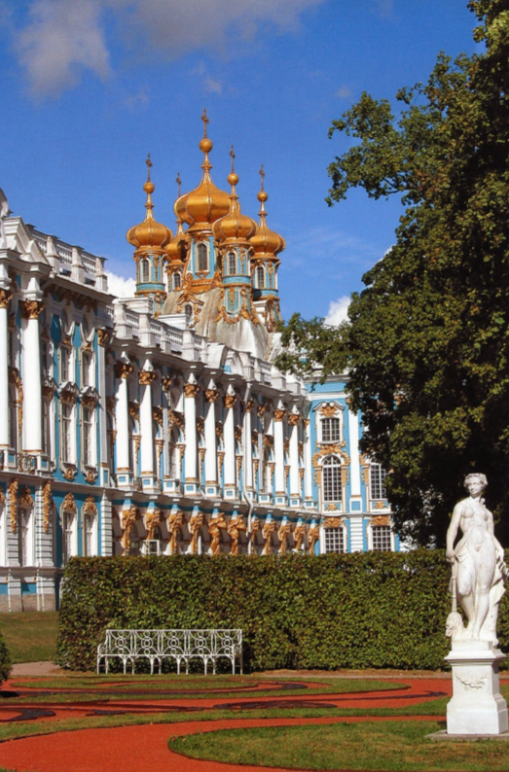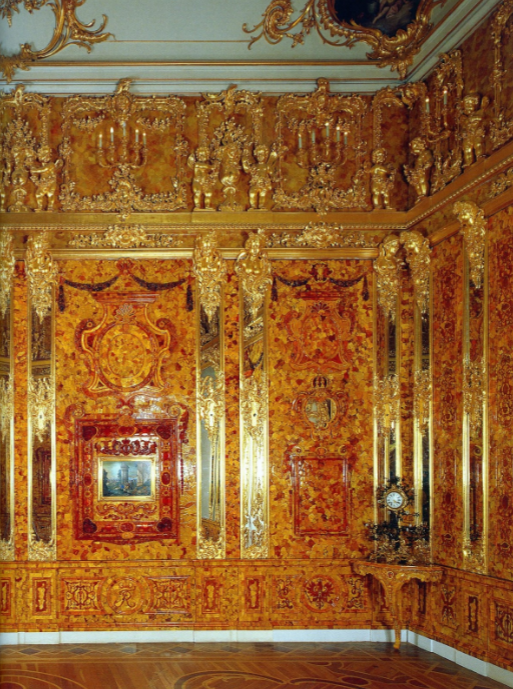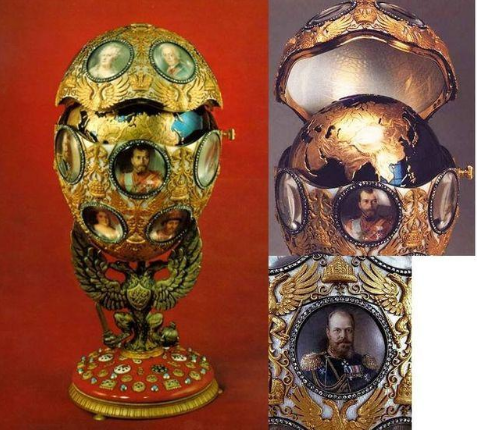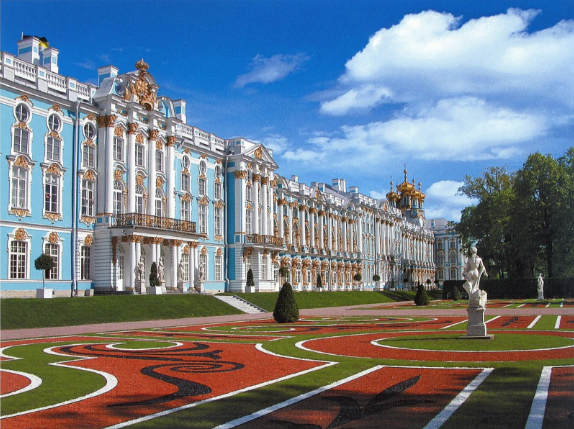Pyotr Ilyich Tchaikovsky–Piano Concerto No. 1 in B flat Minor, Op. 23-1. Allegro Non Troppo


I have always been fascinated about mysteries linked to the Amber Room. When my husband and I were in St. Petersburg, one of the main sites we visited was the Amber Room located in Catherine the Great’s Summer Palace, in Tsarskoye Selo, (Tsar’s Village) the town of Pushkin, one hour outside the city.
The Amber Room was made in the early 1700’s for Friedrich I, the first king of Prussia, for his country estate near Berlin. But it didn’t remain there long, for Peter the Great admired it on a visit, and in 1716 Friedrich’s son presented it to Peter as a gift to cement their Prussian-Russian alliance.
It took almost 40 years to be shipped and installed in Peter’s small Russian town. Six tons of amber were used for the room’s design, including extra precious Baltic amber. Due to the room’s unique splendor, it was often called the “Eighth Wonder of the World.”
Unfortunately, history can bring tragedies and the Amber Room was looted during World War II by the Germans as they entered Leningrad on their “Eastern Front.” Knowledge of its whereabouts was lost in the chaos at the end of the war and the Amber room was never found. It wasn’t until 2003 that it was rebuilt in Catherine the Great’s Summer Palace.
Gift of Diamonds has seen many drafts over the years. In the final and present version, I describe the Amber Room and imagine how Czarina Alexandra filled her Fabergé eggs with rare diamonds. I often wonder, if my imagination was right or wrong?

I would like to share with you in this Back History, the story of diamonds that are still in my Memory Chest. I did not use them in the novel and they are eager to come out and entertain you. They are part legend, part fantasy, and entirely fun.
This extract comes from the scene when Mica and uncle Simion are at Christie’s to have their diamonds appraised by Mr. Walters, the expert in diamonds:
“Traditionally, diamonds are cut into fifty-eight facets, but an unusual French jeweler, who was also an explorer during the 17th century, by the name of Jean-Baptiste Tavernier, believed that if a diamond had more facets, it would reflect more light back to the viewer’s eyes. Tavernier knew more about diamonds than anyone before or after him.”
At the mention of Tavernier’s name, Mica dropped her sack of jewels. Ben had mentioned his name. Mr. Walters was too excited to notice her alarm. He continued on.
“Tavernier hand-cut his diamonds by using a smaller, pointed diamond. He carved his diamond into sixty-two facets like this one, where the back of the diamond is flat so it’ll reduce light from leaking out of the jewel.
“This is one of Tavernier’s diamonds!” Mr. Walters yelled, losing all semblance of self control. His horned-rimmed glasses fell off his nose and a button on his three-piece suit popped. “There are only four diamonds in the world that have this blue color and are cut into sixty-two facets with this type of back.
“This is the missing blue Russian! The St.Petersburg. I’m sure of it! I’ve seen pictures of it. I even drew a sketch of it when I was a student. Look at its deep color.”
He was so excited that he could hardly talk. He took a glass of water as he sat down and loosened his bow tie.
Mica started to shake. She knew Tavernier had existed, her father had told her so. But now hearing Mr. Walters, the American expert, say that her diamond was one of Tavernier’s, made her feel faint. She poured herself a glass of water. She opened up her jacket. She started to tremble.
“Tavernier,” Mr. Walters continued, “traveled from France by boat in the 1640’s to visit the last Mongolian Emperor of India. The Emperor showed him a huge diamond, more than one hundred carats, that came from the Kollur mine in Galconda, India. It was triangular, crudely cut and a very unusual blue color, almost violet.
“It had a strange history. The first documentation we have is from Tavernier’s own diary which he started when he was visiting the Emperor. This diary is real. It became his famous memoir, ‘Six Voyages.’ I read it in the Bibliothèque Nationale in Paris.
“He wrote that a Persian leader invaded India and wanted the large diamond from the Emperor of India as part of the booty. The Persian conqueror had learned that the Emperor kept the blue diamond hidden in his turban. He invited the Emperor to have dinner with him and assured him that he wouldn’t kill him, he just wanted to socialize with him. Over dessert, however, the Persian suggested they exchange turbans to solidify their friendship. The defeated Emperor had no choice but to oblige – there were twenty Persian soldiers surrounding him.
“In turn, the Persian victor was later assassinated. The blue diamond went to his son who was tortured to death because he wouldn’t give up the diamond. From there it went to another son, who himself endured a few tortures, including having his head boiled in cooking oil.
“His wife, who briefly wore the diamond around her neck, was afraid of more misfortune so she decided to sell it to Tavernier, who was still in India.
“Tavernier took the blue diamond back to France, christened it the Grand Tavernier diamond and cut it into smaller gems. However, he didn’t pay heed to the warning that he should not cut the large diamond into smaller ones. They would all be cursed!”
“S-sir,” Mica interrupted Mr. Walters, “do you believe these stories?”
“Some people say they’re tales or superstitions, others say they’re history. Who’s to say when a story is real or not? If you believe it, it’s real.”
“Do you think I should be superstitious?” She thought of the diamonds in her bra, in her boots, in her hopes, her dreams. She felt nauseous.
“Mica,” Simion said, walking toward her. “Are you all right? You look pale.”
She held on to the table. She thought she’d faint. “We must sell these diamonds as soon as possible,” she stammered. “Do you think a potential buyer will be aware of these stories?”
“I don’t know…” Mr. Walters answered while shaking his head.
“But with the correct publicity and advertising, we can get people to see another aspect of the diamonds. Another facet.” And he smiled, pleased with his pun. “It’s in our interest, too.”
“Yes,” Mica responded, but she wasn’t convinced.
“Let me tell you about another blue diamond cut from the Great Tavernier.
“The Bonaparte diamond is square in shape, forty-three carats. Tavernier sold this one in 1669 to the Sultan of India who in turn sold it to a Japanese samurai. The samurai got involved in a battle and had to relinquish the diamond when he was faced with a sword between his eyes. His conqueror took the diamond without anyone knowing. To make sure that no one learned about his acquisition, he slashed a hole in his leg, stuffed the blue diamond into the wound and wrapped the leg in a bandage. He traveled to the Sea of Japan where he found a captain who agreed to sail him to Russia. Once at sea, the captain stole the jewel from the Japanese soldier who had bragged about his diamond wound when he was drunk. The captain took the gem, sewed it inside one of the sail’s batten pockets, and voyaged on the Mediterranean Sea toward Egypt.”
Mr. Walters picked up Mica’s blue diamond, smiled, and then continued talking, “Napoleon’s men found the diamond in Egypt, in a Pharaoh’s pyramid when he and his army were there in 1798. Napoleon took the diamond back with him to France and embedded the jewel in his famous sword for his inauguration in 1800. Defying tradition, Napoleon crowned himself Emperor by taking the crown from the Pope’s hands into his own. Napoleon’s bad luck soon followed after he raised his diamond sword decorated with the blue diamond.
“Josephine, his first wife, couldn’t give him an heir and as such, although he loved her dearly, had to repudiate her. Talleyrand, his advisor and chief diplomat, arranged a second marriage to Marie-Louise, daughter of Franz Joseph, Emperor of the Austro-Hungarian Empire. Within a year Marie-Louise gave Napoleon a son, Le Roi de Rome – L’Aiglon.
“Napoleon’s happiness did not last. He started losing on the battle field. After Waterloo, he was exiled to the island of Elba and then after ‘the hundred days,’ he was exiled again to St. Helena, where he died in 1815 alone and miserable.
“Marie-Louise had returned to Vienna with the blue diamond, prying it from Napoleon’s sword. She was a greedy woman.”
Mica put her hand on her heart.
“Misery followed the diamond. Her son, called The Duke of Reichstadt by the Austrians, died in his early twenties. Some say he was poisoned by Metternich, the most important statesman of his era, and the most ambitious.”
Mica covered her mouth. Simion gave her an angry stare. Mr. Walters talked on.
“The Bonaparte diamond stayed in Vienna with Marie-Louise, until her father, afraid of the diamond’s curse, insisted she send it back to France. She listened to him, but it was too late. She had already possessed the diamond. In fact, the story goes that Marie-Louise was quite possessed – she was cursed to be a nymphomaniac.”
Simion moved closer to hear better.
“In 1821, she married General de Neipperg, an Austrian count. It seems he died of a heart-attack or more precisely, over extension, trying to satisfy her desires. Widowed, Marie-Louise continued to indulge in her favorite pleasures. One day, she was with her entourage strolling in the Viennese Woods. Admiring a young lumberjack, she approached him. ‘Come with me,’ she said.
“He, thinking she was a witch, crossed himself several times and ran away. Arriving at his cabin, he met his father and his five brothers. They all saw Marie-Loiuse running after the lumberjack… It was said, she had not only him but his entire family.
“Metternich was not happy with Marie-Louise; he exiled her to Palma. But in the sun, her activities were not curtailed. He sent an envoy, the Count de Bombelles, to survey her. She did what was good for her, seduced him and then married the Count. Continuing her escapades, in 1834 she was exiled again. The Count sent her to Bad Ischl to drink the bromide waters hoping to calm her down. He posted a guard to watch her. After many guard,s and a lot of bromide water, she returned home to her husband. One night she went to the opera. It was with a handsome tenor that she enjoyed her last song.
“Some people suggested that on her tombstone should be written, ‘Here lies a woman who started with an Emperor and ended with a tenor.’”
Everyone laughed, even Mica.
Mr. Walters went on with his narration, getting more and more excited. “The French government displayed the Bonaparte diamond in the Louvre. But when the Germans invaded Paris in 1940, the French took it to a chateau in Bordeaux where they hid it in a stone wall. The chateau was bombed but the blue diamond survived – it was found amid the rubble. After World War II, the blue diamond was returned to its place in the Louvre where it now rests out of trouble.”
Mica stopped smiling. She wondered what would happen if she couldn’t find buyers for her diamonds. Would she be forced to donate them to a museum? No, she thought to herself. Never! Not after what I went through. I need to save my parents. I can defy the curse and create my own life. I’m not afraid!
“A hundred years later,” Mr. Walters said, “after Taverniewr sold it to Peter the Great, the diamond turned up again when Prince Orlov in 1774 bought it as a gift for his mistress, Catherine the Great. But bored with Orlov, she ousted him from her bed, kept the Orlov diamond, and found pleasure elsewhere.
“Legend, or history, tells us that Prince Orlov wrote Catherine a letter informing her that the diamond had a mate – another round shaped blue diamond from Tavernier’s original one, a little less than forty carats. He called it the St. Petersburg diamond. If she’d agree to take him back, he’d give her the mate. Catherine refused. She preferred her freedom to the diamond, enjoying many other mates. Somehow, she got the St. Petersburg as well.
“All her diamonds were passed down to the last Romanovs, her heirs. Czar Nicholas paid dearly for Catherine’s treasures.
“When the Romanovs were assassinated in Sverdlovsk, it was said that the Czarina wore so many diamonds on her chest, that the bullets ricocheted throughout the room. The only way to destroy the last Romanov was to shoot her in the head.

“These bullets triggered the Bolshevik Revolution; Russian history changed. The Bolsheviks took over the Czar’s palaces and turned them into museums.”
Suddenly Mr. Walters shouted, “This blue diamond is the St. Petersburg diamond that was in their summer palace’s Amber Room! I’ve seen pictures of it! Listen to me!”
He rolled the blue diamond in the palm of his hand as if it were dice and he was ready to roll his lucky number. “The Amber Room has become a symbol of how war can destroy art.”

Mica looked down and in a bare whisper said, “This diamond survived.”
“Yes!” Mr. Walters shouted, laughing. “Let me show you how special this diamond is. It’s classified as a type IIb diamond which phosphoresces a strong red color after it’s exposed to ultra-violet light. I’ll demonstrate what I mean.”
He took some instruments from a wall cabinet. “Look at the red color!” he almost screamed. “Only Tavernier’s blue diamonds phosphoresce red. Look at the color meter. The diamond is turning as red as blood! This is the missing blue diamond!” he yelled. “The only one left of Tavernier’s blues! I’ll show you pictures.”
Mica closed her eyes. Was her blue diamond cursed?
